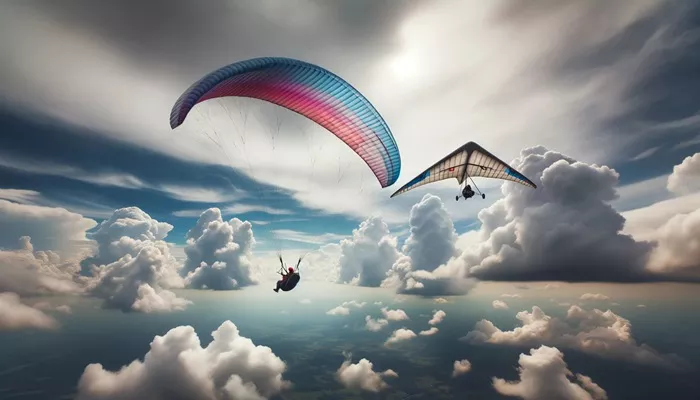The world of extreme sports offers a thrilling escape from the ordinary, and among these activities, paragliding and hang gliding stand out as popular choices for adventure seekers. While they share similarities, such as the exhilaration of flight and reliance on wind currents, the two sports differ significantly in equipment, techniques, and overall experience. Understanding these differences is crucial for anyone considering taking to the skies. This article will explore the distinctions between paragliding and hang gliding in detail, providing insights into their unique characteristics, advantages, and challenges.
Overview of Paragliding And Hang Gliding
Both paragliding and hang gliding allow individuals to experience flight without the use of an engine. They are both forms of non-motorized flight, relying on natural air currents for lift. However, the way each sport is practiced varies widely:
Paragliding involves flying with a lightweight fabric wing that resembles a parachute. The pilot is suspended in a harness beneath this wing.
Hang gliding utilizes a rigid frame covered with sailcloth, creating a triangular shape that offers improved aerodynamics.
These differences lead to distinct flying experiences, making each sport appealing to different types of enthusiasts.
Key Differences Between Paragliding And Hang Gliding
1. Equipment Structure
The most noticeable difference between paragliding and hang gliding lies in their equipment:
Paragliders consist of a flexible wing made from durable fabric that inflates to create an airfoil. The pilot sits in a harness suspended below the wing.
Hang gliders, on the other hand, feature a rigid structure composed of metal frames covered with synthetic sailcloth. This design gives hang gliders their characteristic triangular shape.
This fundamental difference in structure affects how each type of craft handles in the air and how pilots control them during flight.
2. Pilot Position
The position of the pilot during flight is another significant distinction:
In hang gliding, pilots lie face down in a prone position, similar to Superman flying through the air. This position allows for direct control through body weight shifting.
In contrast, paragliding pilots sit upright in their harnesses, which is generally more comfortable and less intimidating for beginners.
This difference in posture not only affects comfort but also influences how pilots interact with their craft during flight.
3. Control Mechanisms
Control techniques vary between the two sports due to their differing structures:
Paragliders are controlled by pulling on brake lines attached to the wing, which alters its shape and changes direction. This method is relatively gentle and intuitive.
In hang gliding, pilots steer by shifting their body weight. While this requires some core strength and can be physically demanding over long flights, it provides a more direct connection to the craft’s movements.
4. Speed and Performance
Speed is a crucial factor for many thrill-seekers:
Hang gliders can achieve higher speeds—up to 80 miles per hour (128 km/h)—due to their aerodynamic design.
Paragliders typically have lower maximum speeds, around 46 miles per hour (75 km/h), making them more suitable for leisurely flights rather than high-speed thrills.
This difference means that hang gliding may appeal more to those seeking adrenaline-pumping experiences.
5. Flight Duration
Both sports rely on thermal updrafts for sustained flight time:
Flight durations can range from as little as 10 minutes to over an hour for both types of gliders, depending on weather conditions and pilot skill.
However, paragliders often have an advantage in staying aloft longer due to their ability to catch thermals effectively.
6. Landing Techniques
Landing approaches also differ significantly:
Hang gliders require more space for landing due to their speed and glide ratio; they often need larger landing areas.
Paragliders can land in smaller spaces thanks to their slower speeds and maneuverability.
This makes paragliding more versatile regarding potential landing sites.
7. Learning Curve
The learning process for each sport varies:
Paragliding is generally considered easier to learn due to its simpler equipment and control mechanisms. Many beginners can complete tandem flights with instructors after just a few lessons.
Hang gliding typically requires more time and effort to master because of its physical demands and complex control methods.
8. Safety Considerations
Both sports have safety measures in place, but they differ in risk profiles:
Hang gliders are often seen as safer for experienced pilots due to their stability at higher speeds.
Paraglider pilots may face risks related to turbulence or landing injuries since they often land on their feet.
Understanding these safety aspects is essential for new pilots when choosing which sport suits them best.
Conclusion
In summary, while both paragliding and hang gliding offer unique opportunities for experiencing flight, they cater to different preferences and styles of adventure. Paragliding provides a gentle, scenic experience ideal for those looking for relaxation amidst stunning views. In contrast, hang gliding appeals more to thrill-seekers who enjoy speed and dynamic maneuvers.
Choosing between these two exhilarating sports ultimately depends on individual preferences regarding comfort, excitement levels, and desired experiences in the sky. Whether soaring gracefully under a paraglider or racing through the air on a hang glider, both activities promise unforgettable adventures that connect enthusiasts with the beauty of flight.
Related topics:
- The 7 Safest Types of Paragliding
- What is Acro Paragliding?
- How Much Does It Cost to Go Paragliding in Manali?

